Cigars of the Pharaoh (French:
Les Cigares du Pharaon)
Original publication dates: December 1932 – February 1934
First collected edition: 1934 (redrawn colour edition published in 1955)
Author: Hergé
Tintin visits: Gibraltar, France (Marseilles), Italy (Naples), Greece (Piraeus), Egypt (Port Said, Cairo, The Valley of the Kings), Saudi Arabia, India (Bombay, Gaipajama)
Overall rating:





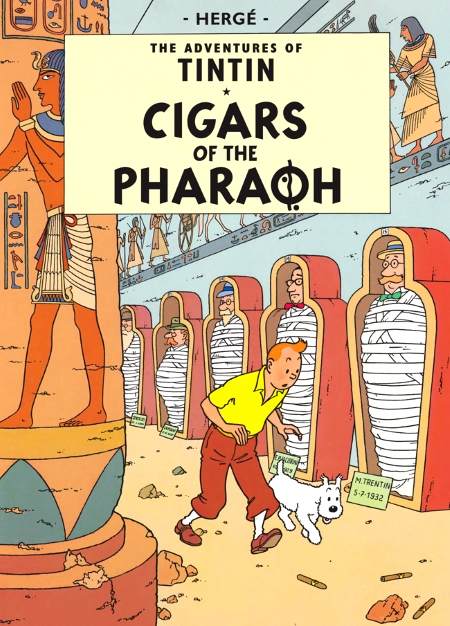 Plot summary available here
Plot summary available here.
Publisher's synopsis:
Scores of Egyptologists have tried to find the lost tomb of the Pharaoh Kih-Oskh; every single one has vanished. When Tintin and Snowy meet the eccentric Egyptologist, Doctor Sarcophagus, they are soon involved in the search themselves—and find that the tomb contains a more sinister secret than sand and mummies. Following the clue of a mysterious symbol on a cigar band, Tintin and Snowy clash with a gang of drug smugglers and are off on a dizzy chase to Arabia and India, plunging headlong into another dangerous battle of wits with an international gangster.Comments: With the increasing success of each of the first three Tintin stories among the youth of Belgium, and with the strip now being reprinted in France as well, Hergé knew that he had hit upon a winning formula. For the boy reporter's fourth adventure, the author decided to send his hero to Egypt and the mysterious Valley of the Kings. Interest in Egyptology throughout Western society was still at an all-time high in the early 1930s, following the spectacular discovery of Tutankhamun's tomb by archaeologist Howard Carter in 1922. The attendant fascination with the alleged "Curse of Tutankhamun", which, it was claimed, had caused the death of Carter's employer, Lord Carnarvon, was fuelled by sensationalist newspaper reports. This mania for all things Egyptological must've made the region seem like an appropriately evocative backdrop in which to set this tale of hidden tombs and drug smuggling.
Unlike the previous stories, Tintin was not dispatched to North Africa as a reporter by
Le Petit Vingtième, but was instead swept up in the adventure while on holiday on a Mediterranean cruise – something that is humorously referred to by the splendidly named Maharaja of Gaipajama in the book's final panel...
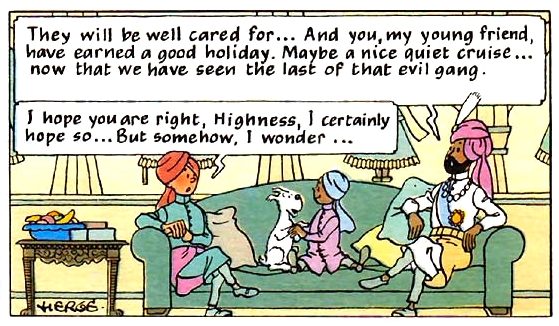
As a result of not being sent to Egypt as part of his job, this is the first Tintin book in which the boy is cast as more of a detective than a reporter. Actually, the title and cover of
Cigars of the Pharaoh are somewhat misleading, insofar as the majority of this adventure takes place in Saudi Arabia and India, rather than Egypt. Nevertheless, the scenes set in Port Said and the Valley of the Kings are wonderfully atmospheric, with some gorgeously detailed artwork and are, arguably, the most memorable parts of the book.
Cigars of the Pharaoh represents the first chronological appearance of the Thom(p)son Twins (of Scotland Yard, in the English edition). The bungling detectives were retroactively given a one panel cameo in
Tintin in the Congo, when it was redrawn in 1946, but this story marks their debut proper. Despite their commonly used moniker, Thompson and Thomson are not actually twins, but – aside from a subtle difference in the style of their moustaches – they are identical. The look of the characters is fully formed right from the get go, with their bowler hat wearing and walking cane brandishing appearance firmly in place...
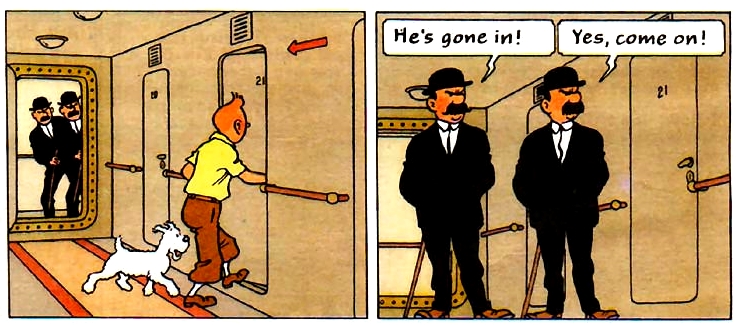
The detectives also use their signature catchphrase of "to be precise...", in which they provide humorous and self-deprecating spoonerisms on a particular phrase, pretty much right off of the bat too...

In French, the policemen were named Dupond and Dupont, which are, so Wikipedia tells me, common surnames in Belgium that are pronounced identically. Hence, the English translators chose the identical sounding Thompson and Thomson.
Myself, I have an extremely low tolerance of silly or bungling characters when it comes to fiction, but I have always loved the Thom(p)son Twins. They are a couple of dimwits, yes, but they have ample charm and usually help a given adventure reach its proper conclusion in spite of their buffoonery. The "twins" were an immediate success with fans of the series back in the 1930s and would go on to appear in every subsequent Tintin adventure, except
Tintin in Tibet and
Flight 714.
Along with the Thom(p)sons, the series' arch-villain, Roberto Rastapopoulos, makes his first proper appearance in
Cigars of the Pharaoh too (although he did have a one panel cameo at a banquet that the boy reporter attended in
Tintin in America). Upon first meeting the film director and millionaire Hollywood tycoon in this book, Tintin notes, naturally enough, that, "it's not the first time we've met." However, as our very own
Roquefort Raider informed us earlier in this thread, this was actually something that the English translators inserted themselves, rather than something that was present in Hergé's original script.
Although Rastapopoulos only makes a significant appearance in five of the twenty-four Tintin adventures (as well as appearing in the animated
Tintin and the Lake of Sharks), I think it's fair to say that the criminal mastermind is the most significant villain of the entire series: Professor Moriarty to Tintin's Sherlock Holmes, if you will. Interestingly, Hergé tries to keep Rastapopoulos's identity as the mastermind behind the drug smuggling ring a secret here, even as Tintin closes in on him and subsequently watches him (apparently) plunge to his death from a mountain cliff edge...

To be honest, it's pretty obvious to the reader who this arch criminal is, even though we never see his face. But, in hiding his identity, Hergé provides enough of a mystery to hook the reader. Though he is apparently dead, Rastapopoulos will re-appear in the next adventure,
The Blue Lotus.
Cigars of the Pharaoh also introduces us to the friendly and extremely persuasive salesman, Oliveira de Figueira...
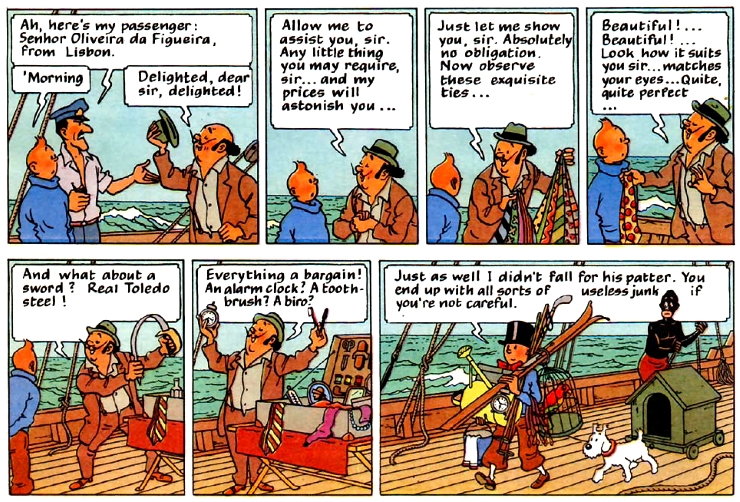
This little scene, in which Tintin ends up weighed down will all kinds of unnecessary purchases, is one of my favourites from this adventure. It's just a shame about the rather unfortunate and decidedly
Tintin in the Congo-esque depiction of an African in the background. We will meet Senhor de Figueira again in
Land of Black Gold. In addition, in the 1955 redrawn colour edition of
Cigars, Hergé retroactively inserted the thuggish henchman Allan Thompson (no relation to the detective), who first appeared in 1941's
The Crab with the Golden Claws.
By introducing these new and soon-to-be classic Tintin characters,
Cigars of the Pharaoh can be seen as a key story in the development of the series. Hergé was beginning to create a cast of characters with which to surround Tintin and Snowy, bringing ever more diversity and scope to the series.
Since the version of
Cigars of the Pharaoh that I'm reviewing is the commonly available 1955 edition, it's no surprise to find that the artwork is of a very high standard. Hergé had, by this point, been using his
ligne claire style – a style that he himself pioneered – for almost 20 years. Stand out moments for me include the atmospheric scene in which Tintin enters the tomb of the Pharaoh Kih-Oskh, only to find the recently mummified remains of the missing archaeologists who had entered the tomb before him...
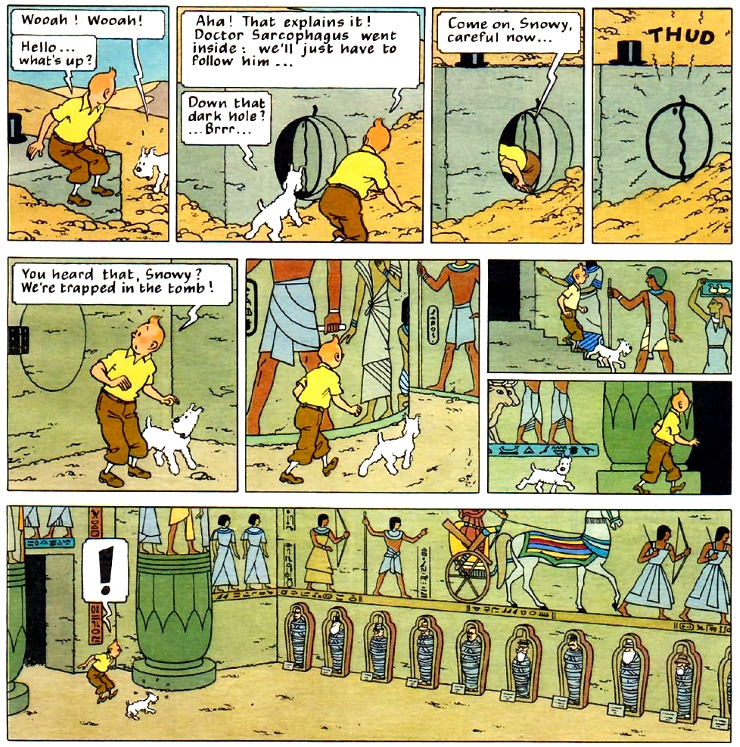
Upon closer inspection, Tintin discovers two empty sarcophagi awaiting himself and his faithful canine...

In the left hand panel above, Hergé slips in a cheeky cameo of his friend and fellow artist Edgar-Pierre Jacobs – as the mummified Egyptologist E. P. Jacobini (this cameo features on the book's front cover too).
Also, note how in the above panels, Hergé has the ground perfectly in line with the lower edge of each panel; Tintin is essentially walking along the bottom of the panels. It's only a little thing, but you see this compositional choice very often throughout the Tintin books and I read a newspaper report, some years back, that claimed Hergé did this deliberately, in order to literally and figuratively "ground" the characters, subliminally making them and their surroundings seem more realistic.
The sequence inside Kih-Oskh's tomb ends in dramatic and hallucinatory fashion, as Tintin and Snowy are knocked out with poisoned gas, allowing Hergé to let rip with a wonderfully surrealistic and sinister dream sequence...
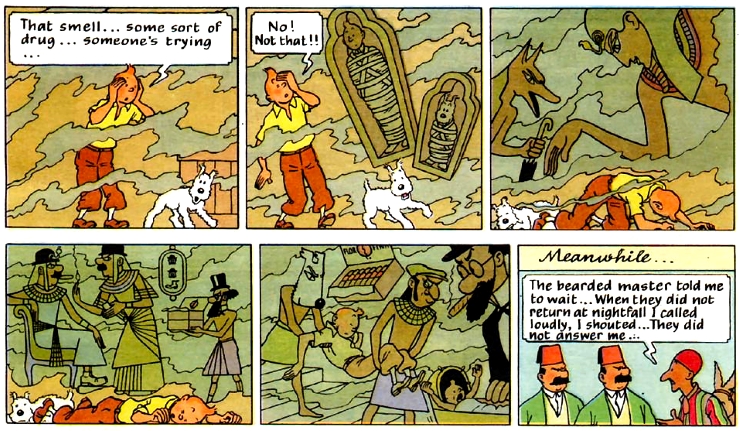
I've spoken in my earlier reviews about how Hergé was starting to take ever greater care to depict backgrounds and locals in a more authentic and historically accurate way, but
Cigars of the Pharaoh marks the moment when the artist began to actively build an archive of reference photographs for his stories. Perhaps one of the best examples of "Hergé the archivist" and how it allowed him to draw locations in a suitably authentic manner in this book, is the scene in which Tintin and Snowy are chased through the gate of an unnamed Saudi Arabian town...
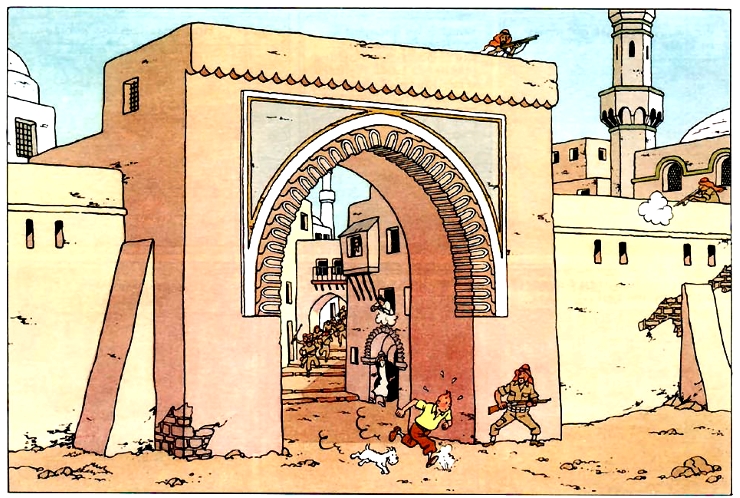
I believe that I'm right in saying that in the earliest version of
Cigars of the Pharaoh, Tintin finds himself in the Islamic holy city of Mecca at this point in the story and is chased through the great gate of the city. In the 1955 version, however, the town is just a generic Saudi Arabian settlement and is not even given a name.
Hergé's artwork shines too in the scenes set in the Indian jungle later on in the book. The tangled and lush flora is drawn with pleasing detail...


You can see in the panels above that Tintin is carrying a wooden trumpet, which he fashioned from a fallen log and which allows him to communicate with elephants. Yes, that's right...talk to elephants!

This is one of the more fanciful parts of the story and, along with a later sequence in which Tintin bounces over a wall, by trampolining on the ample stomach of a sleeping man, is something of a holdover from the more "cartoonish" antics that were common in the earliest Tintin adventures. If you've been reading my reviews, you'll know that I'm not a fan of this kind of wildly unrealistic stuff and I find it unwelcome in this adventure too.
Something else I want to mention is the chillingly creepy fakir that Hergé introduces during the Indian parts of the story. This mysterious assailant is definitely one of the more memorable characters in
Cigars, with his blowpipe and darts dipped in Rajaijah Juice – "the poison of madness" – not to mention his hypnotic eyes...
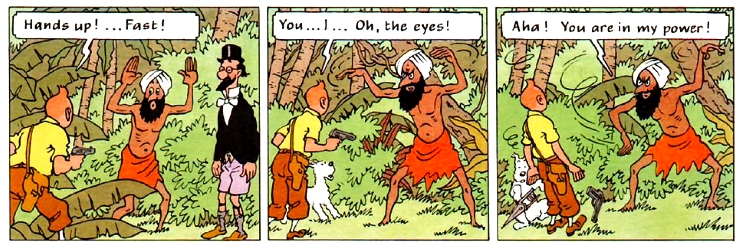
Poor old Doctor Sophocles Sarcophagus is sent completely mad by the effects of Rajaijah Juice, with the unfortunate Egyptologist believing that he is Rameses II. The scenes with the fakir in them are some of my favourite moments in this story. In particular, the panels in which ghostly figures are glimpsed at windows on a stormy night and with the ever present threat of Rajaijah-induced madness looming, proceedings take on a thrilling, Agatha Christie-esque feel...
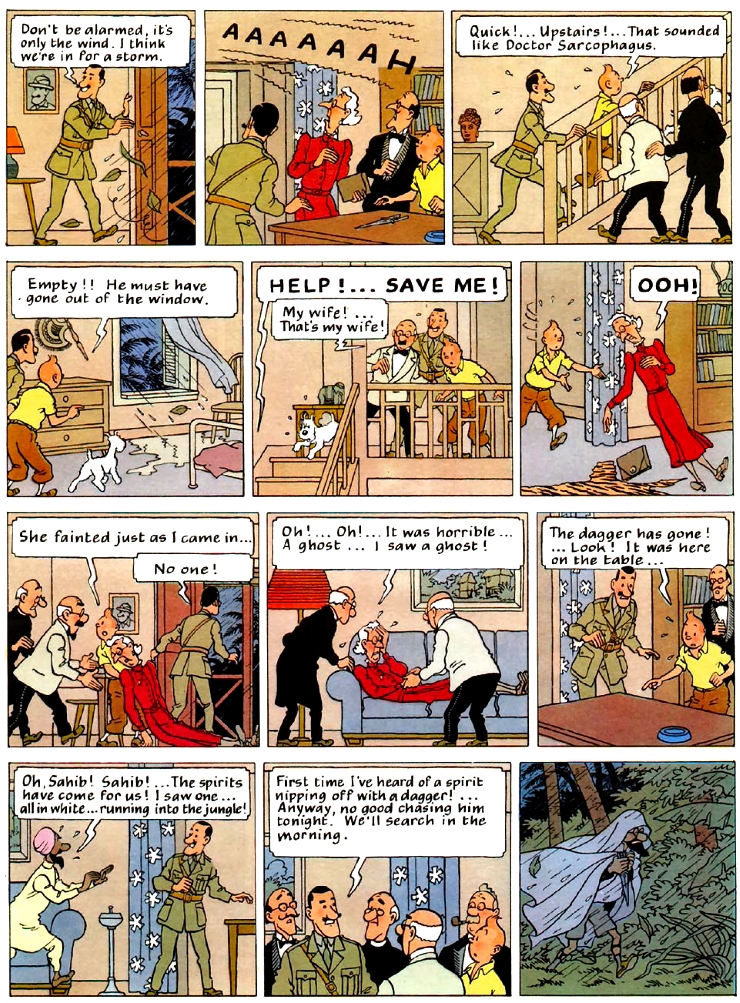
Due to it being one of the later books that Hergé redrew and also one of the last books to be translated into English, there are some niggling continuity problems in the commonly available, 1955 version of
Cigars. For one thing, when the Arabian Sheik has his manservant produce one of Tintin's books, as proof of his affection for the boy reporter, it is
Destination Moon, which wasn't published until 1953, some twenty years after this adventure...
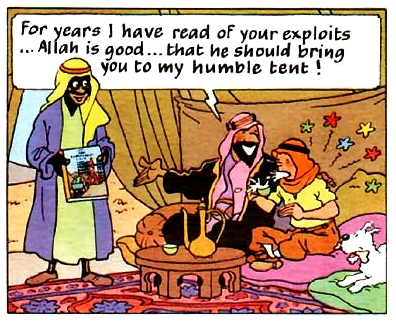
In the original 1934 version, it is
Tintin in America that the Sheik's servant shows the stunned reporter, which makes a lot more sense, given that it was Tintin's most recent book at the time. Then there's another continuity glitch when the English translators slip in a reference to Marlinspike Hall on page 1. Marlinspike wouldn't become Tintin and Snowy's home until the twelfth book,
Red Rackham's Treasure, but since
Cigars wasn't translated into English until 1971 (20 years after
Red Rackham's Treasure had itself been translated), it must've seemed like mentioning the manor house would be fine. The trouble is, it creates a small but annoying continuity error for anyone reading the books in their original order.
Still, I don't mean to be too hard on Hergé's translators. Michael Turner and Leslie Lonsdale-Cooper do an unerringly fantastic job of converting the stories into English, while they actually improve on the names of the author's characters on occasion and almost always inject more humour into them. This book is a perfect example of this, with the delightfully punning names of Sophocles Sarcophagus (
Philémon Siclone in the original), and the Maharajah of Gaipajama (
Rawhajpoutalah in the original). Translated into Hindi, Gaipajama means "Cow's Pyjamas", but it also works as a pun on "gay pajama" – and that would be gay, as in, brightly coloured, not homosexual. The false name that Tintin adopts when he joins the Saudi Arabian army, Ali-Bhai ("alibi"), is
Beh-Behr in the original, so once again this most excellent pun is a creation of the translators.
The punning name of the Pharaoh Kih-Oskh ("kiosk") is
Kiosque in the original French edition, which actually means "kiosk" in French, so that particular pun is Hergé's.
Overall,
Cigars of the Pharaoh is another strong, early entry in the series. It's not as funny as
Tintin in America and it also lacks the pace and pizazz of that adventure, but it has a much stronger over-arching plot and is therefore a much more satisfying read. I really enjoy the increased emphasis on Tintin's detective skills, while the exotic locations make for the most engaging backdrop we've seen so far in the series. Snowy too has a more satisfying role here than in
Tintin in America and, interestingly, it's also revealed that he can communicate with other animals, when he engages a cow in conversation.
Myself, I tend to pair this and the previous book together, in as much as they are about equal, in terms of how much I like them. But they both have quite different strengths:
America is more enjoyable overall, I'd say, but
Cigars is better written and, with its introduction of the Thom(p)son Twins and Roberto Rastapopoulos, feels much closer in spirit to the majority of The Adventures of Tintin than the earlier books do. There's also a lot more happening than in the earlier books and as a result, this is the most complex Tintin adventure we've seen thus far. So, I am going to give this book the same "three stars out of five" rating that I gave
Tintin in America, but for slightly different reasons.
The story of the opium smugglers will be continued in the next book,
The Blue Lotus, effectively making this part one of the first two-part story in The Adventures of Tintin.